The Wrangler exhaust system is an integral part of the emissions and catalytic converter system. Repairs, upgrades and the restoration of an exhaust system can impact the performance of the catalytic converter or cause a vehicle to fail a state or local emissions test. For that reason, exhaust work should always take the chassis and engine emission requirements into account.
At higher mileage, the simplest solution to emission compliance would be restoring the original exhaust system. This means keeping the catalytic converter and any upstream or downstream oxygen sensors. It also means restoring the pulse air system and any on-engine devices that pump or pulse air into the three-way catalytic converter.
For those performing emission-legal engine swaps, be aware that the exhaust system must match the original intent. Simply put, if the chassis has a catalytic converter, you need to install a catalytic converter.
I advise against conversions to dual exhausts on an engine swap, even with a cat on each side. Many Jeep chassis are not suited for this layout.
Jeep Owner’s Bible.
Additional concerns when constructing any exhaust system would be fumes and vehicle occupant safety. I am a strong advocate of running a single tailpipe to the factory exit point at the right side of the chassis. There is no good reason for “side dumps” or an exhaust system that exits before the rear wheels.
The following illustrations will provide a framework for constructing or restoring your Jeep’s exhaust system. Performance cat and muffler options exist that will not violate emissions laws. They can deliver more performance in the form of a “cat back” or legal header and cat-back setup. Consider these options and a smooth flowing, larger pipe single exhaust if engine modifications require more exhaust flow.

Single exhaust is a norm for modern high performance exhaust systems. This smooth Y head pipe on a Jeep 360 V-8 is representative of quality muffler work. Rick’s RV Center constructed this head/exhaust pipe to replace a dual exhaust system that had been installed aftermarket. The size and flow of this head pipe will meet performance demands. Pipe flanges bolt to the original cast iron factory manifolds.
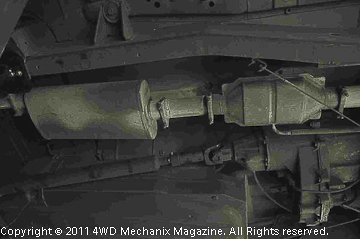
1987-90 YJ models with the 4.2L engine have a three-way catalyst system with pulse-air injection. The pulse-air system pumps oxygen into the cat to aid the oxidation of HC and CO from a carbureted engine. The cat is similar to this 360 V-8 application in a 1987 Grand Wagoneer, which was also carbureted. TBI and MPI engines do not require air injection or a 3-way catalytic converter. The 4.2L six does.

Large diameter pipe and a new performance aftermarket muffler reduce exhaust restriction. The use of a performance replacement catalytic converter was also legal for this 360 V-8 chassis. There was previously a retrofit dual-exhaust system in place without cats (not legal) and with glass packed mufflers. This new single exhaust system—with a low restriction, 3-way cat, a performance muffler plus larger flow pipe—will outperform the previous dual exhaust system. Legal performance is available!
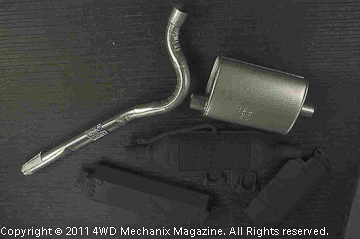
This is similar to the catalytic converter found on 1987-90 4.2L YJ models. Note the pinched and welded air tube. I made this legal modification to reinstall the cat on an ’86 CJ. The use of a Mopar MPI Conversion kit eliminated the pulse-air system and the need for air injection to the cat. This was an acceptable solution for plugging the tube. The TBI 2.5L engines did not need pulse air to meet emissions requirements.
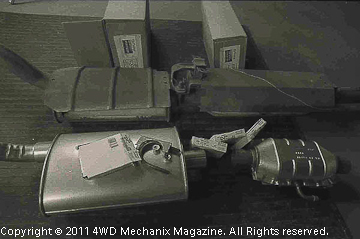
Mopar is a quality source for exhaust components. OE hangers and clamps are the best available. Here, a new Mopar muffler and 3-way type cat will provide like-new performance behind a 4.2L YJ engine. For restoration, the Mopar tailpipe is a wise choice. Note the OE shields that will protect the underside of the body from excessive heat at the cat. These often get left out by muffler shops. If original equipment, shields should be installed to help reduce the risk of heat damage or fire.

Separating exhaust components is not easy. Expensive parts can often be reused, and for that reason, I share the correct procedure for separating a pipe from the muffler or cat on older Jeep models. Later YJ and TJ applications have welded sections that unbolt at flanges. This eliminates the need for a muffler/tailpipe tool like this one.

On a 1987 YJ swap to a 4.0L inline six, I use OE replacement parts to construct the forward exhaust system. The ’91-up YJ engine header pipe is a Mopar OE part that flows well and uses a convenient single exit pipe. The connector pipe is an OE replacement part from 4WD Hardware that fits like the 1991-up YJ factory piece. I prefer this connector pipe setup, which includes the oxygen sensor bung for the Mopar MPI conversion kit’s oxygen sensor. This is the OE oxy-sensor location for 1991-95 YJs.
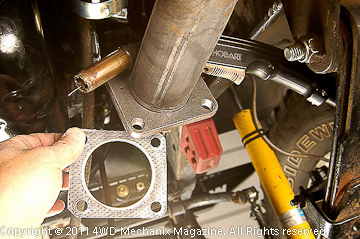
To connect this aftermarket straight pipe to the connector pipe, I will weld a commercially available flange plate to the pipe. The connector pipe uses a heat-resistant gasket at the flange, and the fit will be “factory”. At the header end of the connector pipe, I use an original equipment, cone-shaped steel ring seal for the flange. All hardware will be heat-treated, OE equivalent. This system is essentially stock from the engine to the catalytic converter inlet flange. The cat fits above the skid plate.
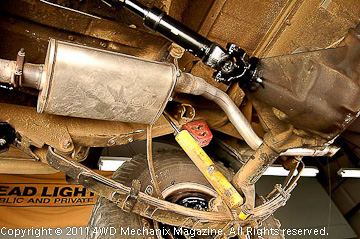
A recently installed performance cat with larger diameter pipe, a performance muffler and smooth flowing tailpipe complete this YJ Wrangler exhaust. This system will handle the 4.0L MPI engine upgrade. The original 2.5L cat and tailpipe would not have offered this diameter pipe or cat and muffler inlet/outlet size. Follow OE examples or consult an exhaust system professional if you swap engines.
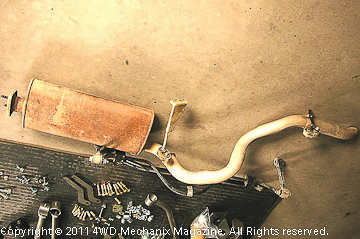
I installed a 4” lift suspension system in a late model TJ Rubicon. The rear suspension modifications required a new shape for the tailpipe. It is not uncommon to find that a suspension lift or powertrain/geartrain modifications also involve exhaust system modifications. A local muffler shop can make use of this “cat-back” OE exhaust system and hangers.
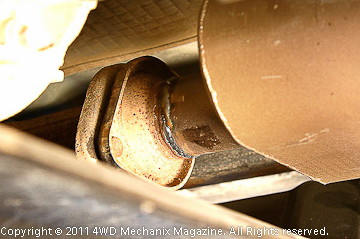
The muffler shop uses this virtually new Rubicon’s cat-to-muffler flange as a starting point. This flange has been cut from the OE pipe just forward of the original muffler. Welded to the new muffler inlet, the flange will bolt in the stock location, making this installation neater and easier. The original catalytic converter and downstream O2S remain in place. This cat-back approach is legal and will be much easier to service.
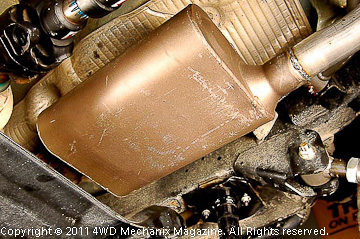
The muffler is a high performance, low-restriction type. This is legal, as the muffler is rearward (downstream) of all emissions related exhaust components. On a 4.0L inline six, you can also use Borla’s 50-State legal bolt-on header package, which is available through the Mopar Performance program. For this late-model TJ powertrain, the original header pipe and catalytic converter will work okay.
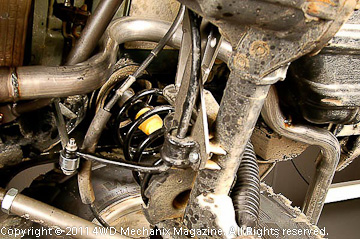
This was a challenging job for the muffler shop! The installer wasted a few pipes on the tubing bender before finding a way around the Full-Traction Suspension V-link suspension system. Note the clearance over the axle to allow full suspension travel. The suspension is at full drop now, and the pipe clears the V-link. This pipe and muffler hang on reinstalled OE brackets and rubber support hangers, a good method.
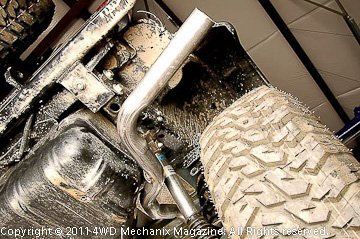
The tailpipe exits at the stock location. Note the pipe shape around the skid plate. The installer has left a dead-air space between the pipe and skid plate to reduce risk of heat buildup in this troublesome, tight area. This pipe also clears the shock absorber over the full range of suspension travel. Always consider suspension and axle movement, brake hoses and any other safety concerns when installing an exhaust system. Route the pipe and its twists carefully.

The exhaust exited straight out from the body, a desirable trait for keeping the cab free of fumes. During engine warm-up, however, this created a spray of water and catalytic converter by-products. To eliminate this problem, a turndown tailpipe tip was fitted neatly at the tailpipe’s end. Fumes exit safely away from the body tub—much like the original equipment design!
